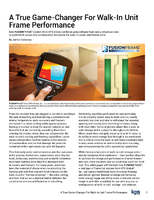Efficiency Leap With IR Drying - Drying of Water-Based Coatings
Drying of Water-Based Coatings
New research on the application of IR dryers to water-based varnishes indicates high energy cost savings. With correct selection of the radiation source the infrared energy requirement for the drying process can be reduced by up to 50%.
Water based varnishes are well known in various printing processes and their usage is growing. The printing industry uses these transparent coatings mainly for in-line surface finishing of printed items to achieve a higher gloss, to reduce post-process times or for surface protection. To increase printing speeds, dryers often combine convection (hot air) with IR radiation.
This research demonstrates the practical features of IR heaters in dryers, their energy requirement (and thus efficiency), their effect compared to hot air, and the possibility of increasing the printing speed. It should also supply many more answers to help in understanding the process.
In order to optimize the drying process with IR heaters, the effect of the IR radiation must be precisely analysed. Figure 1 shows the spectral absorption characteristic of water films with thicknesses of up to 10µm. Obviously the spectral absorption range around 3µm is best suited for heating water. In addition, higher wavelengths of the emitted radiation are absorbed, but the spectral fraction of the IR heater is less there, as is its influence. The wavelength range below 2µm (towards the visible light end of the spectrum) has no significance whatsoever for water heating.
Which IR Source is suitable?
The question which IR source is best suited to the process must be answered based on the spectral absorption of water for different film thicknesses. Figure 2 shows the spectra of different IR heaters operated with the same electric power but at different heater temperatures. The main absorption range of water is marked. The different radiation intensities of the IR heaters in this range explain the results obtained in the practical tests.
The significant effect lies in the spectral range 2.5 to 3.5µm. The energy radiated by the heaters in this spectral range is different. It can be calculated from the area below the relevant spectral curve. The area below the curve of a heater at a temperature of 2600°K is hatched. In comparison with this, the area under the 1500°K curve is significantly greater.
It can be deduced from this consideration that the directly usable part of the infrared radiation of an IR heater is greater the closer its peak emission (see Figure 2, above ) gets to around 3µm. This condition is best met with medium wave heaters.
The classification of IR heaters according to temperature and peak emission is given in the table in Figure 2 above.
We calculate the effective portion of the IR radiation, taking into consideration the water absorption graph ( Fig. 1 above :10µ-film) and the spectral radiation of the different heaters.
Figure 3 (above) then shows the efficiencies for the individual heaters increasing with decreasing heater temperatures. It is to be noted that with falling heater temperature (below 1200°K) the convection losses of the radiation sources rise significantly and can no longer be ignored. However, with optimum process control, this disadvantage can be compensated for, and consequently is not taken into consideration in Figure 3 above.
The theoretical comparison of the different radiation sources shows that the efficiency is high using medium wave radiation and that with decreasing wavelength the part of the radiation absorbed in the water film decreases. Comparing the efficiency of a 2600°K radiation source with a 1500°CK source, it can be seen that the efficiency rises from ~ 13 percent (2600°K) to 28 percent (1500°K). This theoretical result indicates a leap in efficiency (a doubling).
Series of Experiments
The proof of the increase in efficiency has been established in two independent series of experiments. Tests were carried out at a test plant and on a printing machine.
o Laboratory coating equipment at the HTWK in Leipzig. Here a paper web was offset-printed with ink and then finished in-line with water based varnish. After passing through the drying section, the degree of drying was checked in-line by a suitable procedure. The web speed was then increased until the surface started to become tacky. The data on reaching this "tacky" speed, the surface temperature and the energy input were recorded. The installed power intensities with different heaters in the same dryer were:
1. short wave heater at about 2600°K, 82-100 kW/m2
2. carbon heater at about 1500°K, up to 52 kW/m2
3. medium wave heater at about 1150°K, up to 42 kW/m2.
The quoted powers represent no practical limits but were selected purely to simplify the experimental procedure.
o Printing machine experiment: Here also different IR heaters were fitted in a dryer on a printing machine (sheet-fed offset) and compared. Energy input and print quality were recorded and compared at different speeds. The comparison of the test results showed that, at the same speed and the same degree of drying the energy consumption was by 30 to 50 percent lower with medium wave IR heaters. See Figure 3 above.
This practical test runs proved the theoretical conclusion and the question of which is the best IR heater in practice was answered. The medium wave carbon heater is the most efficient radiation source and achieves energy savings of up to 50%. With the demands of today's printing industry, naturally one should ask the question of how easily all this can be converted into practice. High operating speeds demand high power densities with fast response times as well as an easy integration with existing dryers.
The carbon heater offers high performance and today's construction principles allow high power intensities (up to 80 kW/m2) with response times in terms of seconds.
Results and Summary
Practical comparative drying tests show that a carbon heater at 1500°K requires only half of the energy for the drying process compared with a short wave IR heater.
Carbon heater technology can be fitted in today's dryers. As a result of the fast response time and the high power density, this technology is now used in applications which have hitherto been purely the province of short wave IR heaters. Furthermore the low starting current of the Carbon heater eliminates the need for expensive soft start facilities required for short wave systems.
In further tests, it has been shown that the efficiency leap described in this article is just the start of energy saving in the drying of water-based dispersion lacquers. The laboratory experiments and analysis indicate an energy-saving potential greater than 50%. In addition, higher power densities are technically achievable.
These findings are based upon research and experiments at the HTWK in Leipzig with Prof. Dr. E Herzau (HTWK Department of Polygraphic Technology), calculations by Prof. Dr. U Krönert (FH Kaiserslautern/Electrotechnology/Physics and Optical Technology), and by research at the Application Center of Heraeus Noblelight in Kleinostheim, in collaboration with the company Piller GmbH (in Mechernich).




